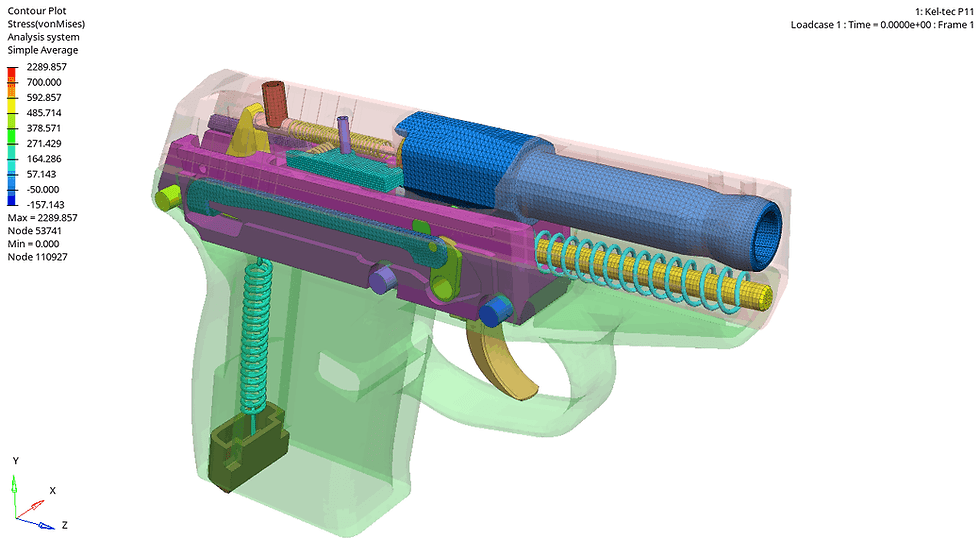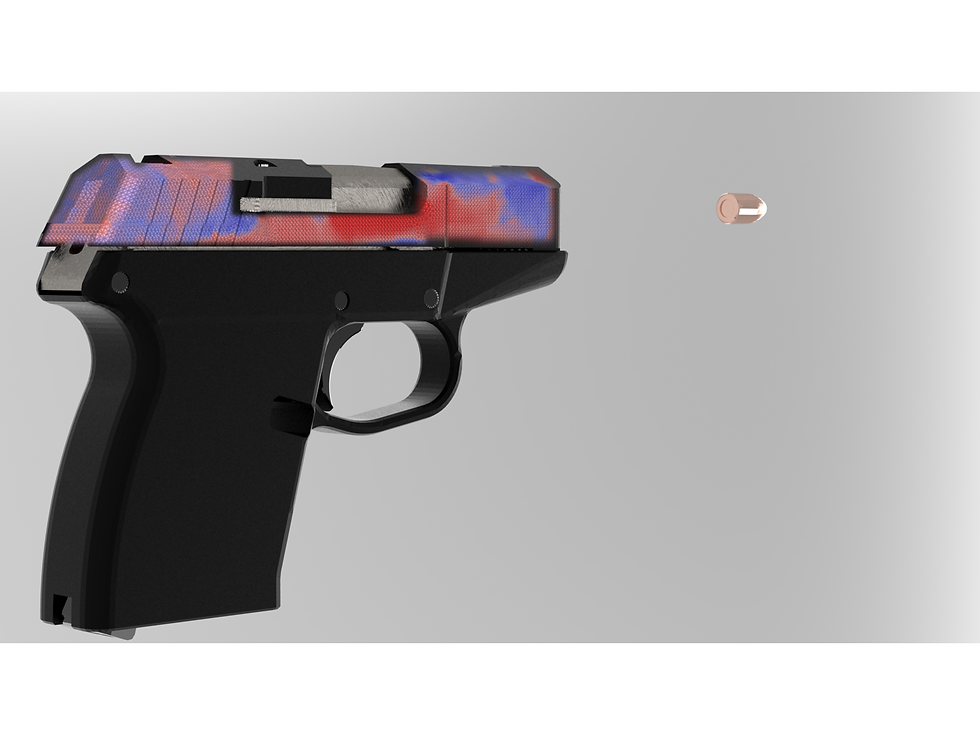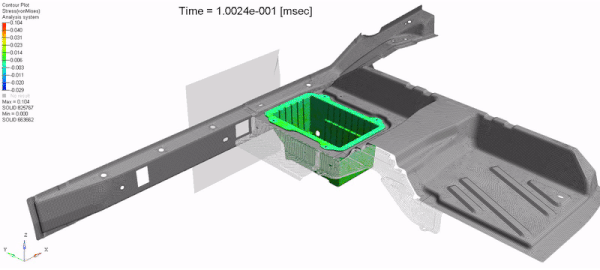
PROJECTS
From Idea to Simulation

Soda can crash

Rendering of Buckling simulation of a prosthetic hand, crashing soda can
Main aim of this simulation was to demonstrate rendering and texturing of a simulation results.
Soda can was modeled based on standard 0.2 mm thickness made of aluminium.
One of the challenges is to demonstrate and achieve a proper buckling of the aluminum foil, for achieving this goal a non linear material model. with damage accumulation was used - with Wierzbicki [1] failure model.
The prosthetic hand is a rigid material.
To simulate the contact between the hand and the can, a non linear stiffness interface was used,
The non linearity is essential due to the material plasticity of the soda can after buckling occurs.
Final render was applied on the results using Altair - Evolve. https://solidthinking.com/product/evolve/
[1] Bao, Y. and Wierzbicki, T. 2004. On Fracture Locus in the Equivalent Strain and Stress Triaxiality Space, International Journal of Mechanical Sciences, V. 46, pp. 81-98.
Internal Ballistics



An Internal ballistics simulation using Fluid Structure Interaction (FSI) method
The aim of this simulation was to show the capabilities of the FSI approach for solving the dynamic behavior of Kaltec P11 pistol.
Gun powder is simulated with Smoothed Particle Hydrodynamics, SPH, Elements [2],[3]
The motivation behind the use of SPH particles in these kind of simulation, is, the fact that they capable of extremely large deformations, which is more complicated in traditional FSI simulation when a CFD solver Coupled with structural explicit solver.
Gun powder is modeled with Jones Wilkins Lee Equation of State, JWL - EOS [4]. this equation of state is often used to simulate explosives.
All parts, including springs are modeled with FEA explicit method, that means - all parts show the strains stresses and other mechanical outputs.
springs are pre-tensioned in a different simulation, and strain and stresses of the pre-tensioned springs added to the complete model.
[2] https://en.wikipedia.org/wiki/Smoothed-particle_hydrodynamics
[3] Randles P.W. and Libersky L.D., “Smoothed Particle Hydrodynamics: Some recent improvements and applications”, Computer Methods Appl. Mech. Engrg. Vol. 139, pp. 375-408, 1996.
Arkal Automotive

Battery Tray crash
Simulation of a front vehicle chassis, assembled with an Arkal-Automotive battery tray.
Aim was to check battery tray capability of withstanding a car frontal crash at 56 km/h, check and compare material behaviour and part behaviour to real life testing.
In this simulation the maximum acceleration reached a peak of 50g.
*The above video is the propety of Arkal- Automotive, and more info and simulations can be found on their page -
https://www.arkal-automotive.com/product-design
Bullet hits soda can



Fluid Structure interaction with 9mm bullet hits a soda can
The purpose of this simulation is to simulate high velocity impact using an explicit solver.
The simulation introducing an XFEM ( eXtended Finite Element Method) crack propagation and element failure technique (ALTAIR - Radioss)
Further, the water in this simulation is modeled with the use of SPH [3] elements.
Finnaly a render of the simulation is done with the use of SolidThinking - Evole.
Helmet test




Soft material Helmet - ground hit
This simulation is a part of Development process of a soft material helmet.
The aim of the simulation is to check if there are catastrophic failures in the helmet materials and can the helmet withstand a ground hit without peaking acceleration of 300[g].
The simulation Boundary conditions were configured based on the CPSC standard for helmet testing -
https://www.cpsc.gov/Business--Manufacturing/Business-Education/Business-Guidance/Bicycle-Helmets
The helmet material is hyper elastic, modeled with Ogden material law [5],
Ogden material law in short, describes the behavior of in-compressible (Poisson's ratio ~ 0.5) hyper elastic materials, capable of high deformations (strains of 600%).
In contrast to the classical solid mechanics, where the small displacement theory is used, when dealing with highly deformable materials the use of non linear solid mechanics must take place [6] [7]
[5] https://en.wikipedia.org/wiki/Ogden_(hyperelastic_model)
[6] Bonet, J., and R. D. Wood. "Nonlinear Solid Mechanics: A Continuum Ap-proach for Engieeering." (1997). chapter 6
[7] https://en.wikipedia.org/wiki/Deformation_(mechanics)
Watch mechanism
Watch mechanism - Multi body dynamics
This simulation is a Demonstrative of the Multi Body Dynamics (MBD) simulation of a pocket watch mechanism.
The main purposes of MBD simulations are -
1. Check part behavior in an assembly
2. Contact and reaction forces between parts
3. Springs, dumpers and timing of the assembly
4. Dynamic behavior of assemblies (complete vehicle behavior during bumpy ride, etc.. [8])
The MBD simulations are not an FEA simulation in the classical definition [9], Rather it calculate the Rigid body motion with an exception of Finite elements analysis to use in contacts calculations.
Due to this nature, the MBD simulation takes much shorter time to complete for even very large assemblies.
the drawbacks are the use of Rigid or Elastic bodies, without the possibility to directly obtain stresses and deformations from the calculations (apart from a few exceptions).
The simulation performed with the use of Altair-MotionSolve [10]
[8] Blundell, Mike and Damian Harty (2004). The Multibody Systems Approach to Vehicle Dynamics
[9] https://en.wikipedia.org/wiki/Multibody_simulation
[10] https://www.altair.com/motionsolve/
M-4 Multi body dynamics
M-4 rifle multi body dynamics with rendered output
Multi body dynamics (MBD) simulation of the famous M-4 rifle, with a total of 9 bullets.
the simulation demonstrates the behavior of the rifle during automatic shooting.
Simulation performed on Altair - MotionSolve
Rendered in SolidThinking - Evolve
Heat exchanger




CFD of heat exchanger
Computational Fluid Dynamics simulation, of a heat changer. with constant inflow rate.
The aim of the simulation was to find the temperature field inside the computational domain, while the inlet and outlet temperatures set to be constant values, and unknown heat flux has to be found, such that will yield the desired outflow temperature.
One of the problems the simulation aim to solve, is a very high heat exchange temperature which cause a physical failure due to high temperature.
The analysis is a steady state, with SST - DES turbulence model, boussinesq approximation, and almost 5M elements.






